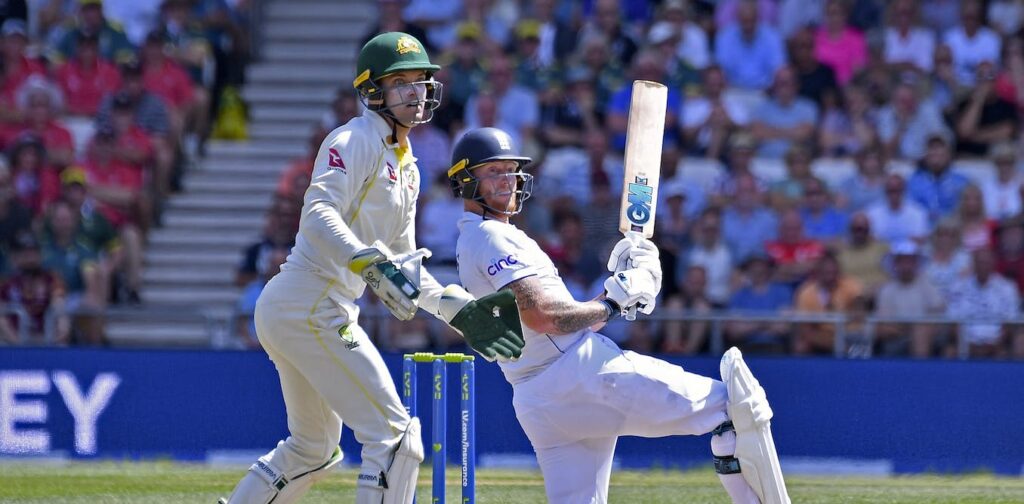The leisurely sport of Test cricket, in which matches last for several days, has been around for almost 150 years. Over the course of that century and a half, cricket has been reshaped by a few crucial events: the “bodyline” era of the 1930s, the invention of one-day matches and World Series Cricket in the 1970s, and the introduction of the even faster-paced Twenty20 cricket in 2005.
We may be living through another pivotal moment in the history of Test cricket: the advent of “Bazball”, a freewheeling, attacking style of play developed by England coach Brendon “Baz” McCullum.
The aggressive approach is seen as carrying high risk and high reward, with the goal of scoring runs quickly and forcing a conclusive result in a game that often ends in draws when time runs out.
Bazball is only about a year old, and some debate its merits and even its very existence. As statisticians, we can’t determine whether Bazball will transform the sport or fade away – but we’ve crunched the numbers and found evidence England’s new approach does represent a genuine break with the history of Test cricket.
What is Bazball?
After a lacklustre 4-0 loss to Australia in the Ashes series two summers ago, England sacked head coach Chris Silverwood. His replacement was the relatively untested McCullum, a former captain of the New Zealand team known for his fast scoring as a batsman.
McCullum only retired from playing in 2019. He is the first international head coach to have played the majority of his career in the era of the frenetic, high-scoring Twenty20 cricket format.
Read more:
The Ashes: how England cricket’s head coach Brendon McCullum developed his ‘Bazball’ style
With this appointment, England has adopted an extremely attacking style dubbed “Bazball” by Cricinfo editor Andrew Miller. The name has taken off in discussions of the stark shift in England’s play, which has attracted attention among cricket fans around the world.
So what is Bazball? McCullum himself recently told a Perth radio show “I don’t have any idea what ‘Bazball’ is”.
Run rates
To understand what Bazball is, and whether it even exists, we turned to the voluminous statistical history of the game.
At the conclusion of the first Test of this Ashes series, 2,507 matches of Test cricket had been played and nearly 2,500,000 runs scored. Across all those matches, the average number of runs scored per six-ball over (known as the “run rate”) has been remarkably stable.
From 1910 to 1919, on average, 3.03 runs were scored every six balls. By the 1950s this had fallen a little to 2.32 runs per six balls, but it has been slowly increasing ever since.
Over the past 20 years, the run rate has averaged 3.29 runs per over, the highest in Test cricket’s history.
What kind of numbers have we seen in Bazball matches?
Comparing Bazball to the past
It might be tempting to compare run rates directly, but run rates can be affected by many factors, such as the total number of runs scored in an innings and the pitch conditions.
For example, an innings with a larger run total will tend to correspond to more runs per over, as there are a limited number of overs. As a result, there is less variety in run rates for innings with larger totals.
We built a statistical model to predict, and capture the variability of, run rates in Test matches. The model took into account the innings total, the year of play, and the location where the match was played.
We fitted the model to the data for run rate per innings. We only included data since 2000, which we define loosely as “modern cricket”.
Further, we excluded data where the innings total was less than 200, as it can be easier to maintain a very high run rate for a shorter innings. This left a total of 2,659 innings for analysis.
As the charts above show, the model does well at capturing how the mean and variance of run rates changes with year and innings total.
Putting Bazball in context
Next, we can measure how far a given innings deviates from the model’s prediction with a number we call the “run rate score”. If the model represents business as usual, the run rate score shows how “unusual” the innings is.
We are interested in high run rates, so we focused on data points larger than what the model predicts (that is, the highest positive run rate scores). We used a statistical approach that can also capture the estimated uncertainty in the run rate scores.
In the chart above, you can see the top 30 estimated run rate scores. There are some uncertainties in estimating a run rate score, so these are shown by the shaded areas. As you can see by the highlighted bars, there are eight Bazball innings in the top 30. This is quite remarkable, given there are only 20 Bazball innings altogether in our data set of 2,659 innings.
This demonstrates strong evidence that Bazball is a very real phenomenon. Whether Brendon McCullum knows it or not, his team is up to something very unusual – as shown in the rest of the latest Ashes series, which was outside our data set but England approached with the same swashbuckling style.
So now that Bazball has faced its toughest challenge yet – the Australian pace attack – and seemingly survived, the final hurdle will be an away series in India in February next year. For now, we will be keeping a close eye on whether other teams follow suit in this revolutionary style of cricket.

